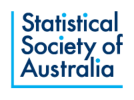SSA Webinar report, 17th August
The 1-hour webinar covered in compressed format the challenge of researching economic disadvantage in Australia given data constraints. The speakers, Anders Holmberg, Chief Methodologist at the ABS and Rajeev Samarage, Senior Data Analyst at the Melbourne Institute, representing respectively producers and users of official statistics, built the case for an entirely new approach to assembling analytical datasets applicable to the economic debates that are being brought on by a rapidly changing economic climate.
This approach is organised around the framework presented by Li Chun Zhang in a 2012 Statistica Neerlandica paper. The Total Survey Error Model had been maturing for a generation from its introduction by Torre Dalenius and co-workers in Sweden to the succession of publications and transatlantic conferences organised by Robert Groves and associates at Maryland as a way of organising the business of population survey taking that had become the central activity of national statistical offices.
The 2012 paper reinterpreted TSE - expressed in terms of the diad of measurement processes and representational units - as stepped generation of errors into the survey dataset - in more general terms palatable to analytical workers: a common conceptual parcel of variables; and objects from a variety of sources.
By this means the statistical task becomes forward looking: to align analytical measures and statistical units brought together into an integrated secondary microdata set, fully documented, and with a level of quality assured.
By allowing the Zhang construction to carry through time we can bring further statistical tools to bear to deliver a credible longitudinal dataset from which the impact of external shocks can be demonstrated, within robust statistical constraints. Equally the fully constructive nature of this process allows for cross jurisdictional conceptual datasets leading into aggregate and comparative study.
The most valuable point however made in the course of the presentation was drawing attention to the contrasting, and legitimate, perspectives of producers and users - so much so that it had been difficult in the past to retrieve a common interest between the two communities:
On the one hand is concern with integrity and an industrialised process at public expense subject to narrow legislative restraints concerning the release of any information that can relate to any one respondents, even though the furnishing of information to the statistical office is privileged over any other producer;
On the other hand analysts have struggled with data access and data fluency issues, with interpreting the specificity of survey designs and underlying limitations in official census sources, with misalignment between official measurement base and that used in other sources where the design is not as transparent or absent, as for some administrative data troves.
A common model means a shared vocabulary, where the methodology used in collection design and production is converted to strengthened analytical reach, meeting the rigour required for research publication, and the lucidity and authority required of political communication.
That ABS and MI are working in harness is encouraging for the future of official statistics and business analytics; whether the answer to the question posed is at best highly qualified or not.
The presenters have given a limited set of references; other sources are output of workshops on survey nonresponse from the 1990s that mutated into European Conferences on Quality in Official Statistics and their offshoots in international fora; the working papers from the ABS’ long term Data Integration project; and technical papers documenting the design and adaptation of HILDA - since its launch by the MI on behalf of the Department of Social Security in 2001 - and its sister longitudinal studies of economic disadvantage in Europe and North America. It will be interesting to see where this goes in the future.
Stephen Horn
Chair, Official Statistics Section, Statistical Society of Australia
